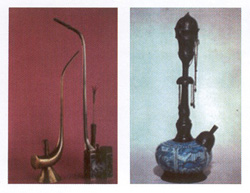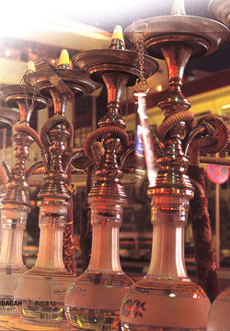|
 By
definition, the Shisha -- also known as “shisha,”
“nargeeleh,” “nargile," “Argilah” or
"Hubble-bubble" (for the muted burbling
noise it makes), is simply a water pipe
used to smoke tobacco. Most likely, it was
introduced to Turkey from India. That was
in the second half of the fourteenth
century. However, it seems that nobody is
quite sure how long before that it was
known to the Indians. Some references
claim that Persia was its origin that
exported it to Turkey, where it has
provided centuries of enjoyment for the
Turkish smokers and spread from there to
other countries. By
definition, the Shisha -- also known as “shisha,”
“nargeeleh,” “nargile," “Argilah” or
"Hubble-bubble" (for the muted burbling
noise it makes), is simply a water pipe
used to smoke tobacco. Most likely, it was
introduced to Turkey from India. That was
in the second half of the fourteenth
century. However, it seems that nobody is
quite sure how long before that it was
known to the Indians. Some references
claim that Persia was its origin that
exported it to Turkey, where it has
provided centuries of enjoyment for the
Turkish smokers and spread from there to
other countries.
Regardless,
whether its origin was Persia or India,
once the Shisha reached Turkey, its route
was destined to go from there to
neighbouring Arab countries - Iraq, Syria,
Yemen and Egypt. At each stop of the
shisha's hazy path, it has developed into
a more sophisticated apparatus. It went
from the rudimentary coconut-and-straw
look of its Indian roots to its current
form, which is essentially a glass vessel
with hoses to smoke from attached to the
body, a head that holds tobacco and hot
coals and a straw that runs from the head
through the vessel.
Initially, smokers used shishas to
inhale pure, hardcore tobacco. Arab
countries have added flavor to the
tobacco, which resulted to the modern,
elegant and enticing Shisha with its
present-day signature appeal.
"With a shisha, you can smoke aromatic
tobacco," one Shisha addict friend told
me. "I've tried flavors like apple,
strawberry, melon and even rose. I just
like the taste of it."
Perhaps the flavored tobacco gave the pipe
an even firmer platform to reach its
popularity. In any case, the shisha hit
its heyday when it reached the Ottoman
Empire in the early 1600s. With the
introduction of the tobacco to Turkey, a
coffeehouse culture centered on smoking
sprung up throughout the country.
The shisha, of course, became the nucleus of social
interactions, a status barometer and,
eventually, a symbolic tradition. Social
gatherings were held around shishas in
classy salons, where men (or women in
their own salons) would yield to the
ecstatic numbness that overcome the senses
with every inhalation.
Shishas eventually became a novelty in the Anglo cultures as
well. The British were big fans, and they
even popped up in the United States during
the 1930s and '60s. Even recently, new
shops catering for the needs of shisha
smokers have come up in many parts of the
world, with prices ranging between 20$ for
the basic one and up top thousands of
dollars for the fancy crystal one with a
golden mouth piece and golden holder of
the clay part.
"I usually smoke it with two or three people," said my friend
Mohammed, who owns a small shisha himself.
"I don't think I'd smoke alone. It's very
social; it's nice to invite friends over
to our favourite Cafe, smoke a bit and
have something to drink.
"Plus, it isn't addictive like nicotine," he added, referring
to the argument that shisha smoking is
more lung-friendly, as the water in the
vessel supposedly filters the tobacco.
"People smoke shishas to relax."
However, his statement is really very controversial. One site
on the Internet quoted a so-called doctor,
saying that each shisha (Tobacco portion
used for a shisha) produces tar and
nicotine equal to 51 cigarettes!!
Logically that is not possible, because
the tobacco used for one shaisha is equal
exactly to 3 cigarettes. Other medical
sources confirm that shisha tobacco,
washed several times before preparation,
then being filtered through water, is
definitely much less harmful than ordinary
cigarettes. Bur nevertheless, it is still
harmful.
In no time, the water pipe or
Hubble-bubble pipe became an object of art
in Ottoman Istanbul, with bottles of
crystal, coloured glass or even silver,
finials in the form of silver flowers or
fruits, gilded pipe bowls and amber
mouthpieces; they were a decorative
appurtenance of coffee houses and wealthy
homes.
Until the early years of the twentieth
century, coffee houses in Istanbul had a
special corner reserved for shisha smokers
- they used to be the earliest and most
coveted customers at Istanbul's coffee
houses. They would be sitting upon the
couch to have their morning shisha before
setting out to work. It is in fact one of
the oldest and deepest rooted traditions
in Turkey, with both men and women finding
great pleasure in smoking the water pipe.
Shishas soon became important status
symbols. Offering one to a guest became an
important sign of high standing and trust,
and withholding it could be taken as a
serious insult. In
Ottoman Turkey shishas were used as a
treaty device. The Turks would offer it to
diplomats in a gesture of peace between
two countries (which reminds us of a very
similar tradition practiced much earlier
by the Red Indians). The shisha's role in
Turkey was so great that a diplomatic
crisis broke out in 1841, when the Ottoman
Sultan refused to offer the French
ambassador a chance to smoke with him.
Not all tobaccos qualified for usage in
the shisha, and only the dark tobacco
imported from Iran (called Ajami) was
favourable with the shisha smoker. This
tobacco was washed several times before
use, as it was extremely strong. Only oak
charcoal was used on the top of the
tobacco. Some professional shisha smokers
used certain fruits, like sour cherries or
grapes in their water containers just to
enjoy the motion it created in the water.
Other people enjoyed adding pomegranate
juice or Rose oil to their water for added
flavor or aroma.
In the Arab World, shishas spread quickly,
especially in Egypt. But the Egyptians
found the crystal bowel too expensive, and
started looking for replacement.
Eventually, they brought a coconut fruit
and made two opposite holes to extract the
syrup inside and then they used a bamboo
stick as a substitute for the rubber tube.
The haggar (clay part) was made of burnt
clay, where you place the tobacco on. Thus
the process of producing the shisha was
launched successfully and the Egyptians
named it “gouza” synonymous to the name of
the coconut fruit in Arabic.
Then the Egyptians had to find the right
tobacco. By that time there were many
people working in selling the rolled
cigarettes, as their trade was
flourishing. It was known that the tobacco
used in the rolled cigarettes was cut in
fine layers, different than what was used
by the Ottomans.
During the early stages of the gouza, the tobacco was not
stable on the haggar, and it became
necessary to solve that problem. In one of
the trials, a person who enjoyed smoking
was having his dinner: bread and molasses
extracted from sugarcane (called Assal =
honey), which was a very popular dessert
in Egypt. He was trying to fix the tobacco
and then suddenly he realized that he
could use the sticky molasses to give
tobacco the required form. The process
ended successfully, stabilizing the
tobacco on the clay and providing the
smoker with a distinguished flavor - and
the new product was called “Massell”.
By the mid eighties, one of the Egyptian companies developed
all massell sister products, with new
specifications all aimed at decreasing the
nicotine. They added paste of fruits that
have strong exotic aromas, such as apple,
melon and strawberry. The packing was also
modernized to keep the flavour and aroma
of the tobacco.
Shishas entered the Arab World when the
Turks occupied the area. Since then it
became an increasingly common scene in
pavement cafés in Damascus, Cairo, Beirut,
Jerusalem and many other cities. Behind
the counter you would find nearly 60
shishas, most available to all, but some
belonging to customers for whose exclusive
use they are reserved. The older smokers
would prefer the strong Syrian or Lebanese
coastal tobaccos, most of which is well
known to the world as Virginia tobacco,
while many younger ones ask for aromatic
apple or cherry blends imported from Egypt
and Bahrain.
It takes about an hour to smoke a shisha of fruit tobacco,
two hours for the stronger stuff. The
smoke is noticeably cooler than cigarette
smoke, and lightly intoxicating. Before
long, the water begins to turn brown and
smokers say it is filtering out many of
the harmful substances that they would
otherwise be inhaling.
In days gone by (probably not totally gone
by!), some smokers used to add to their
shishas different illicit drugs. Sultans
used to smoke a special mixture of opium,
perfume and crushed pearls. At present,
few smokers here and there add hashish and
other drugs to their shishas.
For shisha smokers, “the important thing is not what you put
in the pipe, but who is with you while
you're smoking,” as one of them put it. He
continued. “In cafes, you find good
people, old people, interesting people. As
long as there is a need for company and
friendship, as long as people want to stop
and think, there will be shisha cafes.”
Along the coastal sides of Arabia, people in small towns and
fishing/pearling hamlets, used for almost
two centuries to smoke a particular shisha
made totally from clay they referred to in
the UAE as “al kadou”. However, the shisha
as we know it, was a specialty of Ramadan
tents, and this continued for around 2
decades. By the mid nineties, shisha cafes
opened everywhere, especially in Dubai,
where their number at present is in the
hundreds.
 Some of them have become very popular as
they offer their guests a wide choice of
tobaccos in addition to a variety of hot
and cold drinks. A shisha costs between
5-7 Dirhams along Muttina Street and up to
50 Dirhams in classy cafes of 5 star
hotels that started offering shisha to
their customers to avoid losing them to
the strong competition. In addition, there
are now many shops that sell different
types of shisha. A good shisha in Dubai
would cost around Dh 200, but the price
may be as cheap as 35 Dirhams or as
expensive as 5.000 Dirhams!
Some of them have become very popular as
they offer their guests a wide choice of
tobaccos in addition to a variety of hot
and cold drinks. A shisha costs between
5-7 Dirhams along Muttina Street and up to
50 Dirhams in classy cafes of 5 star
hotels that started offering shisha to
their customers to avoid losing them to
the strong competition. In addition, there
are now many shops that sell different
types of shisha. A good shisha in Dubai
would cost around Dh 200, but the price
may be as cheap as 35 Dirhams or as
expensive as 5.000 Dirhams!
The advent of shisha and its wide spread
did not go unnoticed. In some countries,
official authorities took harsh measures
to stop the habit. While Sharjah banned
shisha cafes, the Egyptian Parliament will
look soon into drafting a law that
prohibits girls(!) from smoking shisha in
public places, and imposing harsh fines
($200-1000, and one year in jail for
second violation). Qatar stopped issuing
new licenses for cafes, leaving only
something like 40 shisha cafes in town,
and banned smoking shisha in cafes along
its Cornish. The city of Taef in KSA
closed 135 shisha cafes, and allowed
smoking shisha outside the city borders
only.
|
